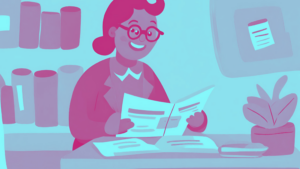The Irish Times recently reported about a secondary school in Co. Mayo who have decided to offer students the opportunity to replace their textbooks with iPads. Essentially, rather than spending €450 on the schoolbooks and bringing them to school everyday in heavy schoolbags, parents can spend about €700 on an iPad with electronic versions of the books on it. The books themselves are simply electronic replicas of the textbooks. There are no videos. There are no interactive quizzes. Doesn’t this sound familiar?
A few months ago, again with great furore and publicity, a secondary school in Co. Meath gave all their first year students a Fizzbook (a tablet/laptop combo) with electronic replicas of the textbooks. So, it’s the same old story except with a cooler device storing the books.
While one could look at these two stories as the first step on the road to integrating technology into education successfully, it also raises questions about why we have to start that process this way.
The only difference between the iPad book and the traditional textbook is the weight. Both are used exactly the same way. Here are a few simple tweaks that the iPad version of a textbook could have done:
Video
A book cannot show a video but an iPad can. Hence, wherever possible, the iPad book could be used to show videos of teaching concepts, real life scenarios, etc.
Internet Links
Let’s say you’re reading about a particular topic and would like to read more about it. A nice list of links to related web sites might be useful.
Dictionary
I’m reading my school textbook and I come across a word I can’t understand. What do I do? A few years ago, a trusty dictionary would come to the rescue. Nowadays, most electronic books can link up to an online dictionary. Simply click on a word and its definition shows up.
Sharing Notes
Your teacher tells you to remember some phrase or definition. In anyone’s language, this means that it is likely to be important (or come up in a test). Let’s say you could highlight this text and save it then share it with other users. Amazon’s Kindle allows this so it shouldn’t be too difficult.
Interactive Quizzes
Most textbooks have revision questions at the end. Surely it is easy enough to make these self-correcting or at very least have the ability to send them electronically to the teacher who can send you back your score or grade.
There’s probably plenty more ways that one could enhance a textbook on an iPad. In fact, it’s quite likely that this will be the route that these textbooks will go down over the next few years as companies head down the road of digitising their schoolbooks.
However, the iPad (and any Internet-enabled device) is capable of producing much more than all this. Even with the above tweaks, these digital textbooks are still textbooks doling out content to students, which they will eventually have to regurgitate at the end of 6th year.
Could the iPad version of the textbooks have started differently? Why did it need to take the textbook and simply digitise it? Why did it not think of some other way to help students learn?
One possibility for the iPad would have been a content-free platform for sharing curriculum knowledge. Students could build their own portfolio according to their own learning needs and styles from an almost infinite bank of knowledge on the web. Why should one book company dictate how it teaches Shakespeare or Boyle’s Law?
Why can’t students find examples of re-enactments of plays and videos of science experiments then store and share them on their own personal learning network?
Why can’t teachers share their notes or their favourite links with their students to help them through the finer details of trigonometry?
Why can’t developers create beautiful games and quizzes for schools that not only challenge their memory but also their skills of searching for information, finding that information and expressing that information well.
Unfortunately, it looks like we’re going to be seeing iPads and other tablets being used in a traditional sense, at least for the time being. I suppose it will be up to primary schools to show them how it’s done properly! 🙂

Podcast Show Notes: 17th – 30th April 2024
This week we talk about the divestment of the first Catholic school to Educate Together, followed by the findings of the Grace report, indicating a


0 thoughts on “iPads replace schoolbooks – great publicity, poor usage”
I’m a little surprised by the list of suggestions for how the digital textbooks could work better given that the ‘EdCo ReaderApp’ has yet to be released? How can you know that it does not contain videos, internet links, note sharing and a dictionary. Have you seen a feature list that shows they are not there, or you making an assumption on this?
Being honest, I can’t. As far as I know, the app is an ePub version of what they already have out there. However, at €200 for the app itself (I think the iPad + app is €700 roughly), you could very well be right. I hope so because at least it will be a start.
I’m a little surprised by the list of suggestions for how the digital textbooks could work better given that the ‘EdCo ReaderApp’ has yet to be released? How can you know that it does not contain videos, internet links, note sharing and a dictionary. Have you seen a feature list that shows they are not there, or you making an assumption on this?
Being honest, I can’t. As far as I know, the app is an ePub version of what they already have out there. However, at €200 for the app itself (I think the iPad + app is €700 roughly), you could very well be right. I hope so because at least it will be a start.
Greetings!
Hope the summer is going well for you.
I have been worried about these two developments also. I can see similar headlines in a few months highlighting schools’ inability to make proper use of technology in general. I really hope they didn’t just dive into ubiquitous computing without thinking it through. Some simple but easily forgotten issues:Have they any systematic approaches in place to ensure the devices are fully re-charged every day? What happens when they are not?
Did the teachers have adequate time to familiarize themselves with the capabilities of the computers? Do the teachers have one?
Are these devices networked and, if so, will the teachers be aware of instant messaging and its potential for use in the classroom?
I really hope it works out well for these schools because the rising tide lifts all boats but that tide can go both ways. The only thing worse than not investing in technology (and its applications) is badly investing in technology.
Hi Dara, great to hear from you. Your points are absolutely spot on. We’re very quick to jump on whatever bandwagon comes along without thinking exactly how these things can be used in education. While the iPad has education potential, I think cheaper and more open tablet solutions will prosper as homemade educational produce comes along.
Hi Dara, great to hear from you. Your points are absolutely spot on. We’re very quick to jump on whatever bandwagon comes along without thinking exactly how these things can be used in education. While the iPad has education potential, I think cheaper and more open tablet solutions will prosper as homemade educational produce comes along.